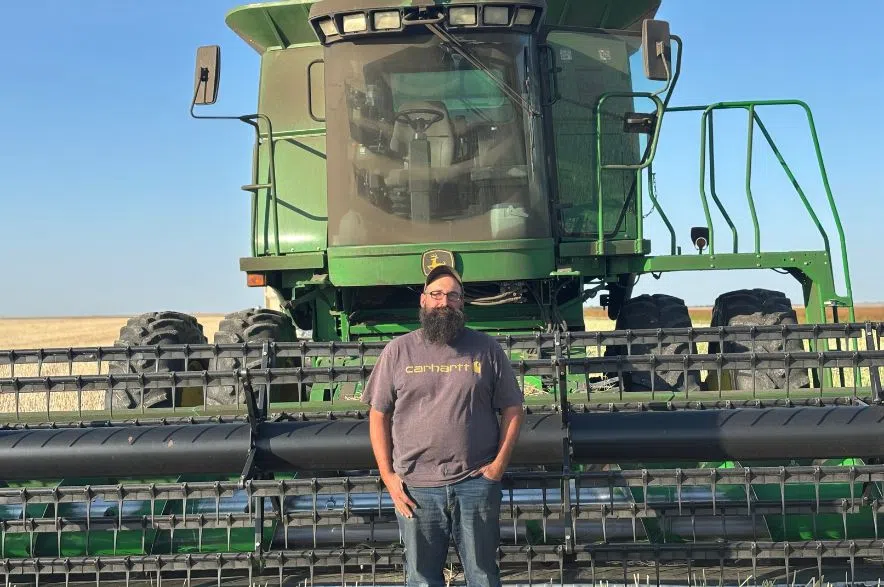When harvest arrives in Saskatchewan, it’s more than just another season for Taylor Leippi.
It’s the time of year when the hum of the combine and the smell of cut grains connect him to a family history that stretches back more than 140 years. Leippi’s great-great-grandparents first settled near Regina in 1893, breaking the soil and building yards that still stand today.
Read more:
- Carney returning to Canada from U.K. trip of meetings and rugby
- One person dead and 9 injured in shooting at Michigan church, police say
- Mounties set up centre to look for missing six-year-old Alberta boy
“I’m either the fifth or sixth generation, depending on how you count,” Leippi said. “We’ve been here since 1893. My grandpa’s 92 now, and he still comes out for rides in the combine. For 90 years, that was all he ever did and thought about.”
The sense of continuity runs deep. Leippi points out landmarks across the fields where his grandmother was born and raised, where earlier generations established roots and where the family farm continues to operate today.
For Leippi, harvest is both a tradition and a trail.
“You can do everything right, make every decision properly and it rains and you get a good crop,” he said. “Or you can do everything right and it doesn’t rain and you’ve got a poor crop. At the end of the day, it’s all the weather.”

A combine unloads grain into a waiting truck during harvest on the Leippi family farm near Regina. (Jacob Bamhour/980 CJME)
This year, his family has been combining canola and durum. Conditions can change by the hour, he explained, with humidity, wind and temperatures deciding when the machines will roll.
“All I can do is be ready to go as soon as it’s ready,” Leippi said. “Maybe it’s 11 a.m. when I start, maybe later. Sometimes you just pull in and try it, and if nothing works you stop, wait for half an hour. It’s a lot of flying by the seat of your pants.”
The Leippis rotate between canola, lentils and durum wheat, sometimes experimenting with peas or other crops. The rotation helps manage disease pressure in the soil and keeps markets more balanced.
“It’s not different from diversifying your mutual funds,” Leippi said. “Chances are they’re not all going to fail at the same time. Lentils like the heat, canola likes more moisture and durum is somewhere in between. Having more than one crop gives you a chance, no matter what the weather does.”
Green lentils can be a tough market, he noted, since they discolour quickly, while red lentils hold their value longer. Canola, meanwhile, remains one of Saskatchewan’s strongest crops, though recent tariff talks have added uncertainty.
“I don’t spend too much time trying to guess the market,” Leippi admitted. “I set a target, and if it satisfies what we need for payments and profit, I’m happy. You can’t beat yourself up over what you couldn’t predict.”
Perhaps the most significant change since his grandfather’s day is the advancement of technology.
“Steering, believe it or not, is a fairly fatiguing activity,” Leippi said. “GPS makes it so much easier after 12 or 14 hours in the cab.”
He still runs a 2003 combine, which he calls “high tech for its day,” but he marvels at what the newest model can do.
“These big X9s have 650 horsepower… they can push twice as much through without slowing down,” he said.
Sprayers have also evolved, moving from broad coverage to pinpoint accuracy.
“The newest sprayers are set up with cameras and AI,” he explained. “You’re not blanket spraying the crops for weeds; you’re spraying the weeds for weeds.”
The technology saves chemicals, money and time, but it comes with a price tag that exceeds $1 million for a tractor and cart.
“I paid $40,000 for this combine,” Leippi said. “It’s still a great, reliable machine. At some point though, the technology gets too old and you’ve got to stay just ahead of obsolete without paying for something you can’t afford.”
While machines change, the soil remains both a blessing and a challenge.
In southern Saskatchewan, the famed Regina gumbo can turn fields into a sticky mess after a rain.
“One millimetre and you’re done,” Leippi said. “Five millimetres and you’d better be parked before it hits.”
At the same time, the heavy soil doesn’t wear down the equipment like the sandy fields further north. His family has run cultivators for more than 40 years without replacing the shovels. Sometimes, he says, other farmers can hardly believe him.

A John Deere combine cuts through a canola field as harvest continues on the Leippi family farm near Regina. (Jacob Bamhour/980 CJME)
“Every region has its quirks,” Leippi added. “North of the treeline, farmers fight rocks, sand and sloughs.”
On his land, the fight is against time. Even small rains can shut down seeding or combining for days.
But despite the many challenges, Leippi says he can’t imagine doing anything else. Farming has always been his way of life, and he hopes to keep it that way for his own children.
“It’s always been part of my life. I really like doing it,” he said. “We know how to farm this area really well, because it’s been 140 years.”
He acknowledged that not every family has stayed on their land that long. Many neighbours sold out in the past generation, and large corporate farms now surround his operation. Still, the Lieppis take pride in keeping their acres family run.
Harvest remains the thread that ties it all together: long days, late nights, unpredictable weather and the constant hum of machines carrying forward a legacy that began more than a century ago.
“It’s one of those things,” Leippi said. “There are always hardships, but there’s also a lot of pride. For us, it’s about knowing we’re still here, still farming the same ground after all these years.”











